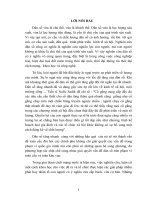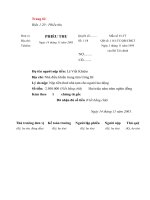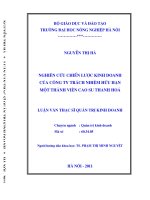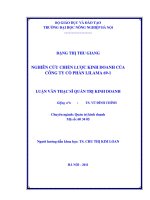NGHIÊN cứu CHIẾN lược KHÍCH lệ được sử DỤNG bởi BAN GIÁM KHẢO TRONG HAI CHƯƠNG TRÌNH TRUYỀN HÌNH THỰC tế AMERICAN IDOL 2010 và VIETNAM IDOL 2010
Bạn đang xem bản rút gọn của tài liệu. Xem và tải ngay bản đầy đủ của tài liệu tại đây (336.94 KB, 47 trang )
PART A: INTRODUCTION
1. Statement of the problem and rationale for the study
It is widely believed that language is a popular and useful tool for human
beings in all societies. Different cultures have their own languages. Therefore,
language helps people not only communicate with each other but also acquire other
communities’ cultures. In fact, the relationship between language and culture has been
taken into account by many researchers and linguists until now. There are many
different opinions around this issue; however, all arguments lead to a common point
about the social interaction between these two items. As Them (2000, p.1-19) said,
language is a product as well as an important part of culture. Similarly, this point is
shared by Hudson (1981): “As for the relation between language and culture, most of
language is contained within culture” and Goodenough (1957): “A society’s language
is an aspect of its own culture…The relation of language to culture is that of part to
people”. Language and culture are two factors playing important roles in
communication. Once language is combined with culture effectively, it is likely to
establish a successful communication.
In communication, encouraging strategies which help people be confident are
very important. According to Fleishman, “most of us, swimming against the tides of
trouble the world knows nothing about, need only a bit of praise or encouragement -
and we will make the goal”. In fact, encouragement is really useful for people in any
cases, even in simple ones. For instance, children who have enthusiastic support from
their parents may learn better than others. Another example showing the necessity of
encouragement is that disabled people would have enough strength to cope with all
difficulties they have to encounter if they are supported by the whole society.
Obviously, the role of encouragement is undeniable. However, this point has not
received as much attention from Vietnamese researchers and linguists as it should be.
1
As mentioned above, encouragement plays an important role in a variety of
aspects of life. It is considered as a type of speech act common in both American and
Vietnamese cultures. This study only focuses on a specific situation in which the role
of encouraging strategies is also incontrovertible. It is in two reality shows named
American Idol 2010 and Vietnam Idol 2010. American Idol and Vietnam Idol are two
reality shows proving a popular attraction for audiences in both these countries. This
study may help viewers have a closer look into encouraging strategies employed in
these two programs, and the similarities as well as the differences in the ways
American judging panels and Vietnamese ones use to encourage the candidates if any.
In addition, these findings hopefully make positive contributions to the success in
Vietnamese American cross-cultural communication.
2. Research aims and research questions
This study aims to investigate common strategies employed by the American &
Vietnamese judging panels to verbally encourage the candidates in American Idol
2010 and Vietnam Idol 2010. Subsequently, the similarities as well as the differences
in the ways American & Vietnamese panels apply these encouraging strategies could
be found out. Additionally, this study is expected to contribute to provide for viewers,
especially Vietnamese ones who are interested in these two reality shows, a critical
look into the cultural factors leading to these differences. With a view to achieving the
above aims of the study, the research questions guiding the investigation are as
follows:
1. What are the common strategies the American & Vietnamese judging panels
use to express verbal encouragement to the candidates in American Idol 2010 &
Vietnam Idol 2010?
2. What are the similarities and differences in the ways the American &
Vietnamese judging panels apply these strategies in the two reality shows?
2
3. Significance of the study
It is hoped that the findings of the study will contribute to provide a realistic
look into encouraging strategies used by the American and Vietnamese judging panels
in the two reality shows: American Idol 2010 and Vietnam Idol 2010. The study,
therefore, could identify potential distinctions between American and Vietnamese
customs reflected in their use of encouraging strategies in these two reality shows.
Moreover, the study is expected to strengthen the cross-cultural communication
between people from the two cultures: American culture and Vietnamese one.
4. Scope of the study
It is widely known that encouraging behaviors are reflected through both verbal
and nonverbal communication. This study, however, focuses only on verbal
encouraging strategies employed by the judging panels in these two reality shows.
Nonverbal communication (including paralinguistic and extra-linguistic factors) is not
discussed in this paper in spite of its considerable importance in real-life
communication.
In addition, only judging panels in American Idol 2010 and Vietnam Idol 2010
are within the scope of this study. Other elements such as audiences, candidates and
other versions of Idol are not taken into consideration in this study.
5. Organization
The study consists of 3 parts, each of which takes responsibility for a particular
function.
Part A: Introduction
This part presents the overview of the study including statement of the problem
and rationale for the study, research aims and research questions, significance, the
scope and the organization of the study.
3
Part B: Development
Chapter 1: Literature review
In chapter 1, all the terms as well as the key theoretical concepts that the study
is based on are clearly explicated so that the next parts of the study can be easily
followed by readers.
Chapter 2: Methodology
This chapter describes the participants and instruments of the study.
Additionally, the procedure applied for collecting and analyzing data for the study is
introduced.
Chapter 3: Results and discussion
Chapter 3 presents the results of the study that the researcher investigates from
the collected data based on the two research questions. Besides, it provides a detailed
discussion about the employment of encouraging strategies by the judging panels in
these two reality shows.
Part C: Conclusion
A summary of the study, the major findings, the implications, the limitations as
well as suggestions for further studies are all mentioned in this final chapter.
4
PART B: DEVELOPMENT
CHAPTER 1: LITERATURE REVIEW
1.1. Cross-cultural communication
1.1.1. Culture
There is a variety of definition of culture from time to time. According to
Levine and Adelman (1993), culture is “a shared background (for example, national,
ethnic, religious) resulting from a common language and communication style,
customs, beliefs, attitudes and values”. In this definition, the researchers tend to
emphasize the association between language and communication to make a full
culture. Similarly, Triandis (1994) defines culture “as a set of human- made objective
and subjective elements that in the past have increases the probability of survival and
resulted in satisfaction for the participants in an ecological niche”.
Besides these ways of defining culture, Kluckhohm (in Clyne’s) hypothesizes:
“Culture is the patterned ways of thinking, feeling and reacting, required and
transmitted mainly by symbols, constituting the distinctive achievements of human
groups, including the embodiments of artifacts; the essential core of culture consists
traditional ( i.e. historically derived and selected) ideas and especially their attached
values. (Cited in Thanh & Trang, 2006, p.4)
Within the limitation of the paper, the definition which seems to be the simplest
one of all is Ferrando’s. He says that “culture is everything that people have, think or
do as a member of a society”. (Cited in Nguyen Quang’s lectures notes)
1.1.2. Communication
5
Communication is an integral factor in all spheres of life. It is an effective tool
helping people share all beliefs, values, ideas and feelings with each other.
Communication, therefore, is very familiar with human beings. However, it seems to
be quite difficult to find out the only definition for it. Up to present, there are hundreds
of definitions of communication. Linguists, based on different features of
communication, try to give their own distinct ones.
As defined by Beisler (1997), communication is “the transmission from one
person to another of a message which is understood by the receiver as the sender
intended”. In other words, communication, which is a process including three factors:
a sender, a message, and an intended receiver, is actually the activity of conveying
meaningful information.
Also regarding communication as a process, Samovar, Potter and McDaniel
(2007: 12) define communication as “the process through which symbols are
transmitted for the purpose of eliciting a response”. From this definition, these
researchers tend to focus on the hearers’ response as well as the means of
communication- the common system of symbols. This is the same opinion as Alder
and Rodman (1997: 3) when they mention communication as “the process of human
beings responding to the symbolic behavior of other persons”.
A little bit different from other researchers, Berko (1989) pays more attention to
features of human communication. He defines:
“The process of communication is a conscious or unconscious, intentional or
unintentional one in which feelings and ideas are expressed in verbal and nonverbal
messages. It occurs in intrapersonal, interpersonal, and public levels. Human
communication is dynamic, continuous, irreversible, interactive and contextual”.
According to him, the process of human communication is a complex one
which is reflected in a variety of different characteristics. Even if people interact with
6
each other by verbal or nonverbal ways, it is necessary for communicators to be fully
aware of the typical nature of communication.
Nguyen Quang also gives a chart of communication and its system as follows:
7
Figure 1.1: Diagram of components of communication (Nguyen Quang, 2001: 9)
8
Extralanguage
-Eye contact
-Facial expression
-Gestures
-Touch/Haptics/Tactile
-…
-Clothing
-Jewellery
-Make- up
-Artificial scents
-Flowers
-Gifts
-…
-Setting
-Conversational
distance/
proxemics
-Time/Chronemics
-Lighting system
-Colour
- ….
COMMUNICATION
Verbal communication
Nonverbal communication
Intralanguage
Paralanguage
-Vocabulary
-Grammatical rules
-Phonetic rules
-Rules of language use
-…
-Vocal characteristics
+ Pitch
+ Volume
+Rate
+ Vocal quality
+ Types of vocal flow
-Vocal interferences
-Silence
Body language
(Action)
Object language
(Artifact)
Environmental
language
It can be inferred clearly from the chart, communication has various functions
and implications. Through communication, people can reveal their own identities,
attract others or cooperate with them. As in the Oxford Dictionary, communication
means “to have a common door with”. Therefore, people communicate as a daily need
for human beings.
In conclusion, although there are many different arguments among linguists
about the definition of communication, it is still an integral need for human beings in
real life. It may be the reason why William gives a statement that “communication
may not save us, but without communication we will not be saved”. (Cited in Samanta,
1993: 1)
1.1.3. Cross-cultural communication
As is mentioned from the previous parts, culture and communication are two
interactive factors. Different countries have different cultures. When having a meeting
between two different cultures, it is likely to cause some serious problems. It is the
reason why the term “cross cultural communication” exists in our life.
Kramsch (1998) defines cross cultural communication as “the meeting of two
cultures or two languages across the political boundaries of nation- states”.
Besides, according to Longman Dictionary of Language Teaching and Applied
Linguistics, cross cultural communication can be seen as “an exchange of ideas,
information, etc. between people from different background”. (1992: 92)
9
Another definition is that “cross- cultural communication involves interaction
between people whose cultural perceptions and symbols systems are distinct enough to
alter the communication event.” (Samovar, 2007)
Levine and Adelman (1993: 94) imply “cross cultural communication is
communication (verbal and nonverbal) between people from different cultures;
communication that is influenced by cultural values, attitudes and behavior; the
influence of culture on people’s reactions and responses to each other”.
It is understandable from these definitions that culture shapes communication
and ways of interpreting communication. Once cross cultural communication happens,
many misunderstandings or communication failures may happen due to different
communicating styles or different background knowledge.
1.2. Speech acts
1.2.1. Definition of speech acts
Speech act is a technical term in linguistics and the philosophy of language. The
concept of speech acts was originated by the Oxford philosopher J.L. Austin in the
1930s and then was developed in his famous book entitled “How to do things with
words” published in 1962. Up to now, it has been widely discussed by many
philosophers and linguists such as Hymes (1964), Searle (1969), Leech (1983),
Levinson (1983), Thomas (1995) and Yule (1996). Although there are many different
ways to define speech acts, these theorists have a point of view in common. It is the
confirmation of the close relationship between speech acts and language functions.
According to Searle (1969: 1), speech acts are “the basic or minimal units of
linguistic communication” and “those verbal acts such as promising, threatening and
requesting that one performs in speaking”. Specifically, in English, there are more
labels of speech acts such as apology, complaint, complement, encouragement,
10
invitation, promise or request. It is believed that when people use their language to
express their ideas, they also perform certain acts. For example, when one says “I will
try my best to be at home for dinner”, his/ her utterance is more than just a statement.
It also aims to perform the act of promising.
Similarly, a speech act, in Richards’ (1992: 342) opinion, is “an utterance as a
functional unit in communication”. In other words, during the process of
communication, “people not only produce utterances containing grammatical
structures and words, they perform actions via those utterances” (George Yule, 1997).
As for Austin (1962), there are three distinct but interrelated levels of action
beyond the act of utterance itself including a locutionary act, illocutionary act, and
perlocutionary act.
• A locutionary act is the act of saying something that makes sense and
reference in the language. For example, the utterance “You should buy that
house” is a locutionary act because the hearer understands the content of this
statement as well as the house mentioned here.
• An illocutionary act is the function of the utterance, performed with an
intention. For instance, the utterance “I swear to give it back next time” is
used to perform illocutionary act of promising.
• A perlocutionary act is the results or effects that are produced by means of
saying something. For example, when one says “It is cold here”, the hearer
may close the windows or turn on the air conditioner.
Of all these three dimensions, the illocutionary act is the most discussed.
1.2.2. Classifications of speech acts
There are many differences in the ways philosophers and linguists classify
speech acts.
11
1.2.2.1. Function-based approach
According to Austin (1962: 151), based on the ways speakers realize their
intentions in speaking, there are five main types of speech acts as follow:
• Verdictives: grade, estimate, diagnose…
• Excertives: order, advise, warn…
• Commissive: promise, bet, guarantee…
• Behabitives: bless, apologize, criticize…
• Explositives: argue, concede…
As for Searle (1983: 240), he draws attentions to how listeners respond to
utterance. His classification includes five categories:
• Representatives: describe or state events. They can be assertion,
description, report, statement…
• Directives: get the listeners to take a particular action. They can be
requests, commands, suggestions, orders…
• Commissives: commit a speaker to do some action in the future. They
can be promises, threats…
• Expressives: express the speaker’s attitudes and emotions toward
something. They can be excuses, thanks, congratulations…
• Declaratives: change state of affairs in the world. They can be naming,
hiring, resignation…
Supporting Searle’s classification, Yule (1996: 55) summarizes the five types of
speech acts with the key features as below:
12
Speech act type Direction of fit S= speaker, X= situation
Declarations Words change the word S causes X
Representatives Makes words fit the world S believes X
Expressives Makes words fit the world S feels X
Directives Makes the world fit words S wants X
Commissives Makes the world fit words S intends X
Table 1.1: The five general functions of speech acts (following Searle 1979)
1.2.2.2. Structure-function based approach
Speech acts are also classified into direct and indirect ones based on the
relationship between structures and functions of speech acts. According to Yule (1996:
54), we have a direct speech act when a direct relationship between a structure and a
function exists, and we have an indirect one if there is not a direct relationship between
a structure and a function. For example, the utterance “It is cold here” can be seen as a
direct speech act if it is just used to make a statement about the temperature in one
room, and it can function as an indirect speech act if the speaker’s intention is to
request the hearer to close the window.
1.2.3. Encouraging as a speech act
Encouragement is a universal act which is not a new term for many scholars all
over the world.
As found in Oxford Advanced Learner’s Dictionary of English, “to encourage
is to give somebody support, courage or hope”.
According to Macmillan Dictionary, similarly, encouragement is defined as
“words or actions that give someone confidence or hope”.
In accordance with the classification of speech acts from Searle, encouragement
can be expressed in the expressive form. For example:
13
- Well done!
- Great work!
Also, encouragement can be classified as a representative:
- You’ve clearly got talent!
- I can see no reason why you won’t become a famous singer.
In addition, encouragement can be considered as a directive type of speech act.
For instance:
- Take it easy!
- Don’t give up!
Last but not least, encouragement also can be expressed in the commissive form
as follows:
- I will vote for you.
In conclusion, encouraging can be seen as a complex type of speech act which
occupies four of five types of speech acts classified by Searle (1983: 240) & Yule
(1996: 55).
1.3. Reality shows
1.3.1. Definition
Based on Wikipedia, a reality television is “a genre of television
programming that presents purportedly unscripted dramatic or humorous situations,
documents actual events, and usually features ordinary people instead of
professional actors, sometimes in a contest or other situation where a prize is
awarded”.
14
In the Free Dictionary ( ), a
reality television is defined as a “television show in which members of the public or
celebrities are filmed living their everyday lives or undertaking specific challenges”.
According to Collins Cobuild English Dictionary for Advanced Learners, “a
reality show is a type of television programming that aims to show how ordinary
people behave in everyday life, or in situations, often created by program makers,
which are intended to present everyday life”. Generally speaking, this definition is
likely to be the most exact and easily understandable one of all.
1.3.2. Idol series
1.3.2.1. Definition
Idol is a reality television singing competition to find out a new musical star.
The show was created by Simon Fuller, and combined many elements previously used
by other shows such as Pop Stars. In this reality show, audience plays an important
role in choosing the winner of the competition. Nowadays, Idol has become popular
and beloved in many countries including Vietnam.
1.3.2.2. Format description
The format of the show is mainly based on the British show Pop Idol, which
was in turn inspired by Pop Stars. The final round of Idol takes place in 10 weeks. In
each week, contestants will have to choose the songs freely or as being required by the
rules of the show. During the show, candidates having the highest number of votes will
not be informed. Only the candidates having the lowest ones in each night are named
and eliminated.
1.3.2.3. Judging
15
At the end of the performance of each contestant in the show each night, a panel
of experts will give comments on the performance of contestants.
As for American Idol 2010, the judging panel consists of A&R executive Simon
Cowell, singer-song writer Kara Elizabeth DioGuardi, television host and actress Ellen
Lee DeGeneres, and singer Randy Jackson.
As for Vietnam Idol 2010, the judging panel includes singer Siu Black, MC
Diem Quynh, songwriter Quoc Trung and songwriter Quang Dung.
CHAPTER 2: METHODOLOGY
2.1. Research design
2.1.1. Selection of subjects
16
The researcher carried out the study based on the 8 episodes of American Idol
2010 including episode 19 (the best 8 males), episode 20 (the best 8 females), episode
26 (the best 10 contestants), episode 28 (the best 9 contestants), episode 32 (the best 7
contestants), episode 34 (the best 6 contestants), episode 36 (the best 5 contestants),
and episode 38 (the best 4 contestants). Besides, the 8 galas of Vietnam Idol 2010
including studio round 3 (the best 14 contestants), gala 1 (the best 10 contestants), gala
2 (the best 9 contestants), gala 3 (the best 8 contestants), gala 4 (the best 7
contestants), gala 5 (the best 6 contestants), gala 6 (the best 5 contestants), and gala 7
(the best 4 contestants) were involved. As for American Idol 2010, each performance
night of the contestants was called an episode while it was named a gala in Vietnam
Idol 2010. Actually, the studio round 3 in Vietnam Idol 2010 is the gala conducted to
find out the best ten performers to continue competing in following nights.
These performances were all shown on television as well as various internet
sources such as YouTube ( the official website of American
Idol 2010 (www. americanidol .com/ ), and the official website of Vietnam Idol 2010
(www. vietnamidol .com. vn / ). From the author’s point of view, these performances
were the most interesting ones which would be extremely useful for the data analysis
of this study. It is the reason why the author selected these subjects. Hopefully, this
considerable size of the samples contributes to ensure the reliability of the study.
2.1.2. Methods of the study
Qualitative and quantitative methods are the two main methods used by the
researcher to collect as well as analyze the data because this combination will help to
promote the effectiveness of the study.
In general, quantitative method is considered as good ways to conduct the study
because it is rather flexible and easy to summarize the data. Moreover, it is accepted as
a form of evidence regarding the study effectiveness. Obviously, quantitative method
17
has a lot of advantages; however, data may not be as rich or as detailed as that in
qualitative methods. Therefore, the researcher chooses qualitative method as a
supplemental way to confine the limitation of quantitative method. Qualitative method
is the one contributing to provide complex textual descriptions of the ways people
experience a given research issue. When used along with quantitative method,
qualitative one can help the researcher to interpret and better understand the complex
reality of a given situation and the implications of quantitative data.
2.1.3. Procedures of data collection
During the process of data collection, the researcher watched all episodes/galas
of American Idol 2010 and Vietnam Idol 2010. After that, the transcripts of
encouraging utterances in the selected episodes/galas were noted down to discover
encouraging strategies employed by American judging panels and Vietnamese ones.
2.1.4. Procedures of data analysis
First and foremost, the encouraging utterances of the judging panels were
categorized into various encouraging strategies. Next, the researcher computed the
popularity of using these strategies by American and Vietnamese judging panels. As a
result, a comparison between American judging panels and Vietnamese ones in the
frequencies of using encouraging strategies has been discovered.
2.2. Analytical Framework
As is mentioned above, encouraging utterances of American judging panels and
Vietnamese ones in American Idol 2010 and Vietnam Idol 2010 have been interpreted
into different encouraging strategies.
According to Van (2010: 30), there are nine main encouraging strategies as
follows:
Strategy 1: Alleviating hearer’s hard feelings
18
It is undeniable that this strategy is very important in life. When people feel too
worried and stressed, it is easy for them to lose control and fail in doing something.
Hence, alleviating their hard feeling would help them more confident and enthusiastic.
For example:
Vietnamese American
- Em hãy cố lên nhé!
- Không có gì phải lo đâu em.
- Take it easy.
- Don’t be afraid!
Strategy 2: Offering help or reward
This strategy is employed by speaker to perform the willing to share hearer’s
problems. For example:
Vietnamese American
- Xong hợp đồng này tôi sẽ
thưởng cho các bạn một kì nghỉ
dài ngày.
- Tớ biết là cậu đang rất bận. Để
tớ giúp cậu một tay nhé!
- Let me give you a hand.
- I will pray for you.
Strategy 3: Giving advice
In this strategy, speaker suggests something that hearer should do to have a
bright future. For example:
Vietnamese American
- Em phải tin tưởng vào bản - You need to study harder.
19
thân và làm tốt đấy nhé.
- Đừng bỏ cuộc. Mình tin là cậu
làm được mà.
- Make sure you are well-
prepared.
Strategy 4: Predicting bright prospect
Speaker encourages hearer by drawing a nice picture of the future. For
example:
Vietnamese American
- Chị tin là em sẽ thành công.
- Nếu em tiếp tục phát huy được
thế mạnh của mình như hiện
nay, em chắc chắn sẽ tỏa sáng.
- I’m sure you will do well in the
competition.
- You will do fine.
Strategy 5: Complimenting hearer
Speaker tries to show that she/ he highly appreciate hearer’s ability, which
makes hearer be confident and optimistic. For example:
Vietnamese American
- Sân chơi này đã thú vị hơn rất
nhiều nhờ tiết mục tuyệt vời
của em đêm nay.
- Trong mắt tôi, cậu hoàn toàn
xứng đáng với vị trí trưởng
phòng này.
- You are really the best choice
for this job.
- For me, you are a great singer.
20
Strategy 6: Showing understanding and sympathy
In this strategy, speaker shows the sympathy to hearer’s situation so that hearer
may not be alone or afraid. For example:
Vietnamese American
- Cháu biết là hai bác đang rất lo
lắng cho sức khỏe của Lan.
- Anh hiểu cảm giác của em bây
giờ mà.
- I know that you are really
stressed now.
- It is hard for you to overcome
these difficulties but…
Strategy 7: Reminding hearer’s responsibility
This strategy is used to remind hearer of his/ her duty. As a result, he/ she tries
more and more to overcome challenges. For example:
Vietnamese American
- Đã quyết định tham gia rồi thì em
phải cố gắng hết sức.
- Sếp phải giải quyết vụ này giúp
chúng em.
- Your effort is very
meaningful for us.
- You must bring success for
our school.
Strategy 8: Suggesting things to do
Speaker wants to share hearer’s difficulties by giving some suggestions for both
speaker and hearer to do together. For example:
21
Vietnamese American
- Chúng ta hãy cùng cố gắng để
hoàn thành kế hoạch đúng hạn.
- Mình cùng làm tốt nhé!
- Let’s do together!
- We will work in group to finish
this task.
Strategy 9: Stating facts
In this strategy, some general rules would be given to make hearer more
encouraged. For example:
Vietnamese American
- Em còn nhiều thời gian để
chuẩn bị mà.
- Tâm lý không tốt sẽ ảnh hưởng
đến phần biểu diễn của bạn.
- The best way to succeed is to
be confident.
- This contract is really important
for our company.
These nine encouraging strategies have been chosen by the researcher to
analyze all the data of the study.
22
CHAPTER 3: FINDINGS AND DISCUSSION
This chapter presents and analyzes the data collected to answer the two
research questions. The common strategies employed by the American and
Vietnamese judging panels to verbally encourage the candidates in American Idol
2010 and Vietnam Idol 2010 are evaluated and interpreted to discover similarities as
well as differences in the ways the American & Vietnamese panels give verbal
encouragement.
3.1. Findings
Strategy 1: Alleviating hearer’s hard feelings
In this strategy, the judging panels employ inspiriting and hopeful utterances to
relieve the contestants’ minds. Evidently, it is common for the contestants to be
worried and stressed when joining in a competition. They may lose themselves due to
23
these hard feelings even though they own real abilities. Therefore, preventing the
contestants from weariness, anxiety, and hesitation seems tremendously useful.
According to the data collected, this strategy is not one of American panels’
favorite strategies because they rarely make use of this strategy to encourage the
contestants. The typical expression of this strategy employed by the American panel
members is:
- You do not have to be nervous. (Randy Jackson – Episode 28: Lee Dewyze)
As for the Vietnamese panel, they tend to use this strategy more frequently and
flexibly than their American counterparts. As observed, the Vietnamese panel
members often give extremely persuasive evidences which are based on the
contestants’ natural and remarkable abilities to alleviate their hard feelings. Moreover,
the ways the Vietnamese examiners express their ideas are not fixed. For instance:
- Tôi nghĩ rằng em không nên sợ. (Tại vì tôi nghĩ là với giọng hát của em như thế
này, với sự tinh tế em có đầu tư cho bài hát của mình thì tất cả những bài hát
nó không có gì khó đối với em). ( Siu Black – Gala 1: Uyên Linh)
- Tại vì đối với chúng tôi cũng như khán giả, tôi nghĩ là một chút nào đó đồng
tình, vì thế em không nên sợ. ( Siu Black – Gala 1: Uyên Linh)
- Em đừng sợ gì hết. (Siu Black – Gala 4: Lều Phương Anh)
- Em đừng lo là những bạn trẻ sẽ không thích bài hát này. (Diễm Quỳnh – Gala
5: Uyên Linh)
Strategy 2: Offering help or reward
The panels take advantage of this strategy to indicate their understanding of the
contestants’ conditions, their willingness to share their difficulties, and their high
appreciation for the contestants’ work as well.
24
While this strategy is not American panel’ favor, it is commonly exploited by
Vietnamese panel. Followings are the popular expressions applied by Vietnamese
panel to offer help or reward.
- Tối nay chị sẽ nhắn tin bình chọn cho em. (Diễm Quỳnh – Gala 2: Trung Quân)
- Tuần trước chị đã vote cho em. Chị hôm nay sẽ tiếp tục vote cho em. (Diễm
Quỳnh – Gala 8: Trung Quân)
- Anh sẽ nhắn tin bình chọn cho em. (Quang Dũng – Gala 6: Văn Mai Hương)
Strategy 3: Giving advice
In this strategy, the panels suggest some ideas which are really useful and
necessary for the contestants to have better performances. Followings are the most
expected expressions:
- Just trust yourself. (Randy Jackson – Episode 26: Siobhan Magnus)
- Please believe. (Randy Jackson – Episode 28 : Lee Dewyze)
- You still need to break out as a performer because you are so close. (Kara
Elizabeth DioGuardi – Episode 36: Aaron Kelly)
- You have to work on your vibrato. (Kara Elizabeth DioGuardi – Episode 36:
Casey James)
- You had better go home tonight and write I can win this thing a hundred times
and believe it. (Kara Elizabeth DioGuardi – Episode 36: Lee Dewyze)
- Chị nghĩ em nên chọn bài hát kịch tính hơn. (Siu Black – Studio Round 3:
Trung Quân)
- Em nên tự tạo cho mình âm sắc riêng thì tốt hơn. (Quốc Trung – Studio Round
3: Lân Nhã)
25









